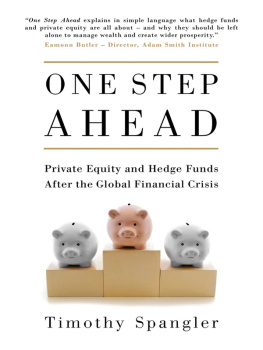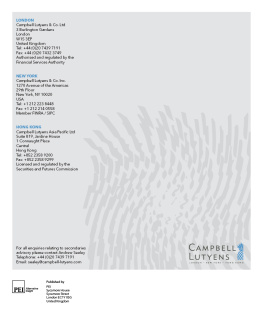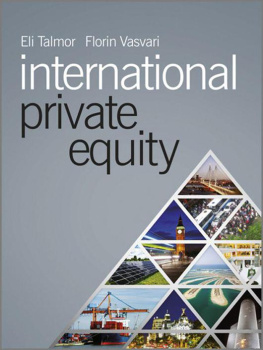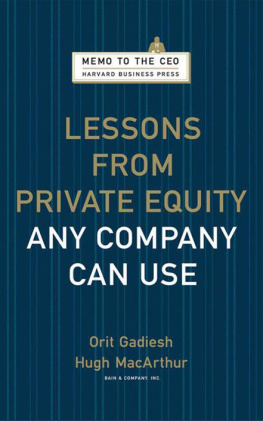
PRIVATE EQUITY ACCOUNTING
The global guide for private equity firms and fund accountants
Mariya Stefanova
PE Accounting Insights
 Published in October 2011 by
Published in October 2011 by
PEI
Second Floor
Sycamore House
Sycamore Street
London EC1Y 0SG
United Kingdom
Telephone: +44 (0)20 7566 5444
www.peimedia.com
2011 PEI
ISBN 978-1-904-696-99-5
eISBN 978-1-908-783-53-0
This publication is not included in the CLA Licence so you must not copy any portion of it without the permission of the publisher.
All rights reserved. No parts of this publication may be reproduced, stored in a retrieval system or transmitted in any form or by any means including electronic, mechanical, photocopy, recording or otherwise, without written permission of the publisher.
The views and opinions expressed in the book are solely those of the authors and need not reflect those of their employing institutions.
Although every reasonable effort has been made to ensure the accuracy of this publication, the publisher accepts no responsibility for any errors or omissions within this publication or for any expense or other loss alleged to have arisen in any way in connection with a readers use of this publication.
PEI editor: Anthony OConnor
Production editor: William Walshe
Printed in the UK by: Hobbs the Printers (www.hobbs.uk.com)
To my wonderful children, Alex and Lilly, who inspired me to write this book, my partner Dimitar who has supported me at all times, and my mom who has always been there to provide a helpful hand.
For all the fund accountants across the world who work so hard with very little to guide them. A special thanks to Anthony OConnor, my editor, who made it all happen. And my sincere gratitude to the expert contributors who have added great value to the book.
Thank you all.
Mariya Stefanova
Contents
Summary |
IFRS 13 and FASB ASC 820 |
Distribution notices |
Country GAAP and fund-defined requirements |
Sample drawdown notice |
Figures and tables
Figures
Tables
About the author

Mariya Stefanova is a founder partner of PE Accounting Insights, a private equity accounting training and consultancy firm, providing specialist training and technical advice for private equity houses, fund administrators and individual fund accountants. She has more than seven years of experience in private equity accounting and more than three years of experience in training fund accountants during which period she has trained over 130 fund accountants.
Previously Mariya was working in the technical department of Augentius Fund Administration LLP, a premium provider of fund administration services specialised in private equity and real estate funds. She was in charge of the technical training of the client services accountants and keeping them up-to-date with the industry and accounting developments. Mariya also provide advice to clients and client-services accountants in resolving complex technical issues, as well as performing technical reviews of accounts, quarterly investors reports and complex calculations.
Before joining Augentius in 2008, Mariya worked for fund administrator Mourant International Finance Administration (now State Street) looking after a portfolio of private equity clients. Before joining Mourant in 2006, Mariya worked for Calyon, a French investment bank and before Calyon she was working for Patron Capital Partners, a leading European opportunistic real estate manager.
Mariya started her career with a large chemical company in Bulgaria where she was chief accountant and was subsequently a financial controller for an industrial catering company. Mariya holds a Masters in Finance and Accounting from the University of National and World Economy (UNWE).
E-mail:
Web: http://peaccountinginsights.com
Introduction to private equity
for accountants
By Mariya Stefanova
This chapter discusses:
A brief history of private equity
How to define private equity?
The mechanics of the private equity fund: open-ended versus closed-end funds
Limited-life versus evergreen funds
Limited partnerships
Regulation in private equity
Private equity as part the alternative investment asset classes
Liquidity
Value creation
J-Curve
History of private equity
From a number of historical sources and varied interpretations of economic history developments, different authors can draw different plots about the history of private equity. To describe the history of this asset class in any significant detail is outside the scope of this publication, so I have included a brief outline of some of the ways in which the private equity industry has developed over the ages without claiming any originality or historical authenticity of my sources. As a private equity accounting practitioner, you may even want to skip this part and dive into the specific areas of interest.
However, it is vital for any accountant dealing with private equity to understand the commercial nature, the mechanics and the transactions of the fund that will be translated into accounting processes and entries later in this book. Therefore, I would recommend that a private equity industry novice read this section in order to gain a deeper understanding of the evolution of private equity.
Whereas some people think that private equity started in the US after the Great Depression in the 1930s, others think that it is as old as human civilisation itself. Pierre-Yves Mathonet and Thomas Meyer, in the introduction to their book, J-Curve Exposure: Managing a Portfolio of Venture Capital and Private Equity Funds, view Queen Isabella of Castile as a private equity sponsor and the purchase of an interest in Christopher Columbus voyage of discovery as a private equity investment whereby she provided not only financial back-up, but also management and recruitment assistance.
This can clearly be said to mimic, to a certain extent, the activities of a contemporary private equity sponsor or manager. Mathonet and Meyer continue with their interesting analogy by describing the refusal of King John II of Portugal to provide financial support to Columbus as an exercise in due diligence, as it followed his request for an independent opinion from his experts on Columbus proposal.
Ancient forms
Ancient Rome and Italy
Exploring the history of the limited partnership the most common legal form for private equity or venture capital funds it seems that the societates publicanorum, which started to be used in Rome in the third century BC, may have arguably been the earliest form of limited partnership. Later on in mediaeval Italy, another form resembling the private equity structure called commenda appeared, where tenth century Italian merchant families financed trade voyages using an early form of limited partnership. This partnership had sleeping partners, who were not liable for any debt and stayed at home (similar to limited partners (LP) in a modern limited partnership), while the travelling partners controlled the venture and set sail to search for profitable businesses (similar to the general partner (GP) in a modern limited partnership).
Next page













 Published in October 2011 by
Published in October 2011 by